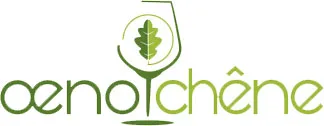Qualité & Process
Secrets de fabrication
Des architectes du vin : voilà comment se définissent les deux dirigeants d'Œnochêne, Jean-Luc Liberto, le président, œnologue de formation, et Jérôme Baudin, le directeur. C'est qu’ils ont conçu un procédé innovant et unique pour la production de bois de chêne pour l'œnologie : un système de chauffe douce par « convection à cœur », induisant l'usage d'air ventilé afin que, dans le four, chaque pièce de bois bénéficie exactement du même traitement par balayage, assurant l'homogénéité de production de la société.
Ainsi, grâce à des températures allant de 100° à 300° selon les profils recherchés, le procédé permet de mettre en valeur les qualités des bois employés.
Le travail du bois
La sélection du bois
Pour la sélection et l’approvisionnement en bois, Œnochêne a mis en place des partenariats forts avec des mérandiers qui lui assurent régularité, qualité et traçabilité des bois.
Le travail des bois, sur toute la longueur de la chaîne, est respectueux de l'environnement, naturel, sans aucun ajout de produit chimique.
Les morceaux de bois proviennent exclusivement des espèces de chêne :
- Le chêne français : le Quercus Petraea
- Le chêne américain : le chêne blanc d’Amérique (Quercus alba)
La maturation du bois
Le bois est entreposé à l’air libre de 18 à 30 mois. C’est à cette étape que s’accomplit une somme de réactions physico-chimiques indispensables à l’affinage de la qualité du bois.
La maturation du bois lui permet de perdre de son excès de composés tanniques désagréables et développe son potentiel aromatique par la transformation de précurseurs d’arômes jusque-là inodores.
Les étapes de la production
Broyage, chauffe, ensachage et traçabilité du bois.
La chauffe
Les bois sont soit laissés à l’état naturel, soit chauffés par convection de manière légère, moyenne ou forte.
Les chauffes par convection (système d’air chaud ventilé) permettent d’avoir une bonne reproductibilité et une chauffe à cœur et homogène.
Pendant la chauffe des bois pour l’œnologie, il se produit une transformation des polyosides du bois (cellulose et hémicellulose principalement) en composés furaniques (notes caramel, grillé), en composés énoliques (sucrosité, pain grillé), en aldéhydes phénols (vanille, épicé, boisé) en composés méthyl-lactones (noix de coco, boisé)…
L’évolution et la formation de tous ces composés sont obtenues en fonction de l’intensité de la chauffe.
L'ensachage
L’emploi des produits est facilité grâce à un emballage adapté.
Les chips, microstaves et ministaves sont conditionnés dans des sacs de polyéthylène de 5 Kg adaptés à une utilisation facile et mise en œuvre dans les caves.
Pour des utilisations en barrique ou autres contenants, des systèmes ont été étudiés et sont mis à la disposition des clients.
La traçabilité: un contrôle qualité rigoureux
Tous les lots réceptionnés par Œnochêne sont contrôlés et accompagnés d’un certificat d’origine.
La traçabilité du bois est assurée de la réception du bois au conditionnement.
Chaque morceau de bois est contrôlé avant chaque transformation et chaque lot subit une analyse sensorielle avant la commercialisation.
La norme HACCP est mise en place depuis 2009.
Plusieurs avantages découlent de ces choix technologiques : un, le procédé permet d'exhauster la sucrosité des bois ; deux, il offre la possibilité, inédite jusque-là, d'obtenir une palette d'arômes presque infinie, du vanillé au chocolat en passant par le pain d'épice et le moka en fonction des profils de chauffe retenus. Enfin, et c'est tout l'intérêt, il magnifie les qualités des vins, en les soulignant, autant le volume que la longueur en bouche, la complexité aromatique ou le fruité.
Si Œnochêne a créé une palette de profils de chauffe, appropriés à des types de vin, la société a aussi développé une gamme de morceaux de bois adaptés à l'œnologie, allant des chips, les microstaves, au staves, les merrains. En outre, une gamme Quality One, spécialement destinée aux vins premium, rejoint le catalogue, par sélection de bois très haut de gamme, nécessitant un travail spécifique plus complexe encore.
C'est toute l'ingéniosité d'Œnochêne : la société puise dans son savoir-faire en œnologie pour sélectionner les bois qu'elle utilise après les avoir affinés. Elle dispose en permanence de 100 à 150 tonnes de bois sélectionnés et séchés au grand air de 18 et 30 mois. Œnochêne examine alors la granulométrie de chaque lot et détermine le dosage à prévoir en fonction des singularités des vins : pH, TAV, turbidité…
Bref, un travail d'artisan, mais aussi d'œnologues que vous pourrez découvrir en goûtant les vins qui en sont issus dans la salle de dégustation de l'entreprise.
